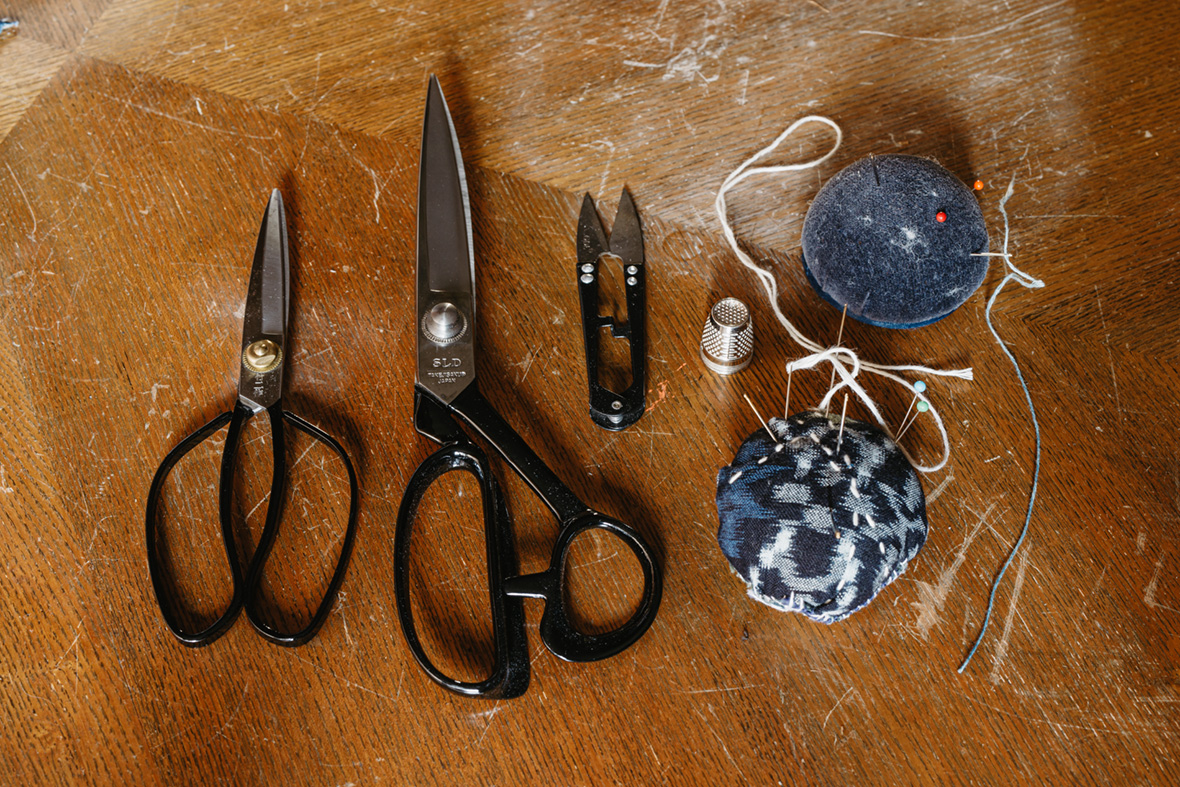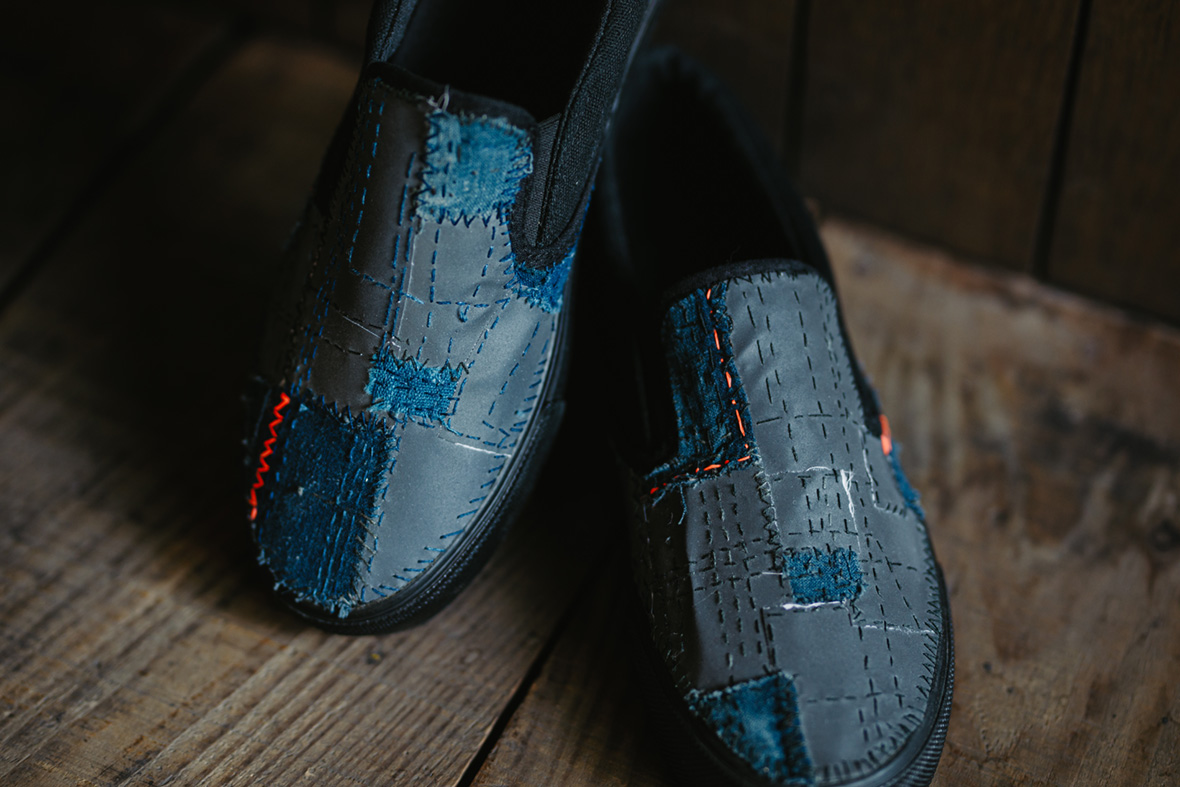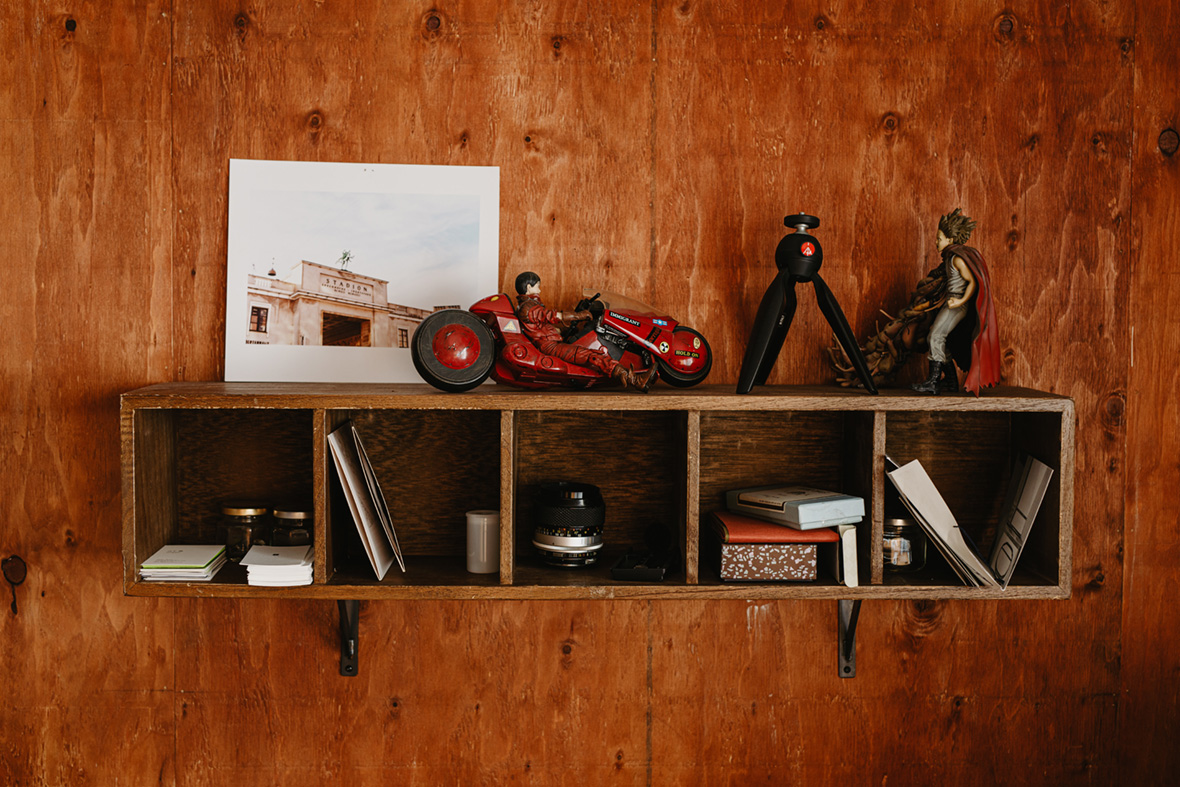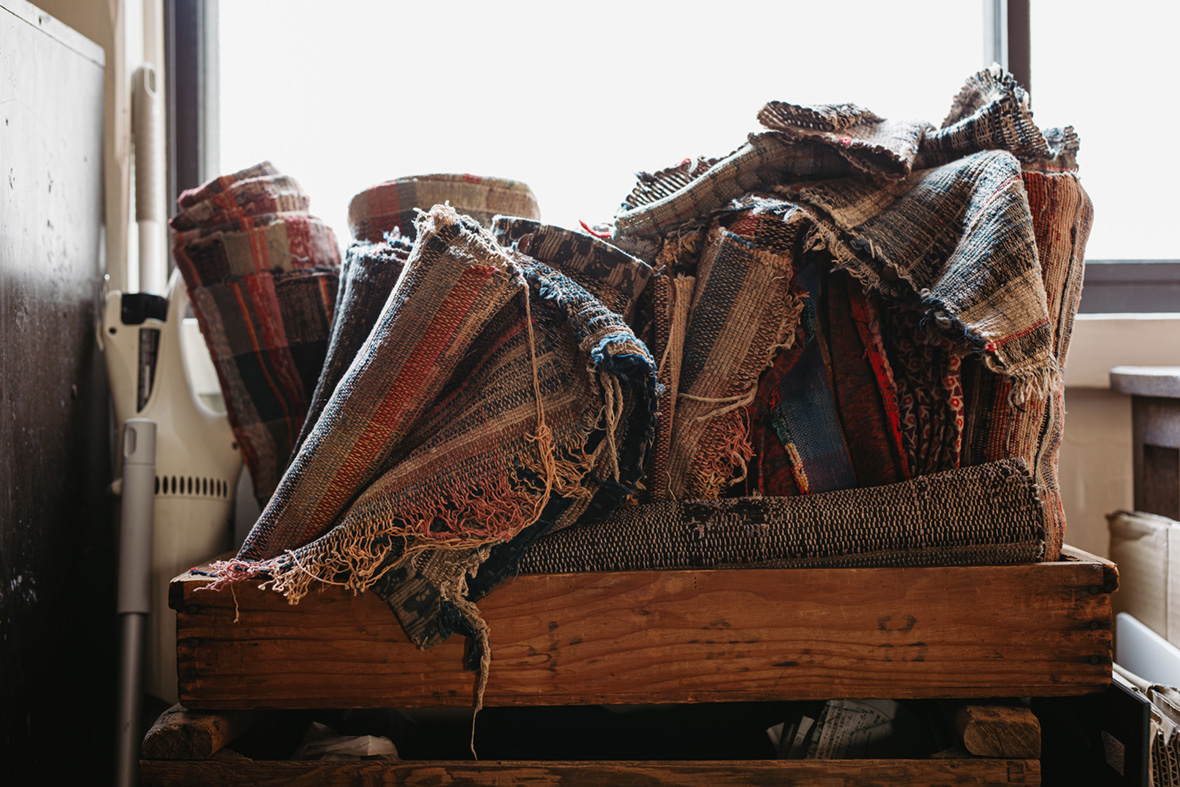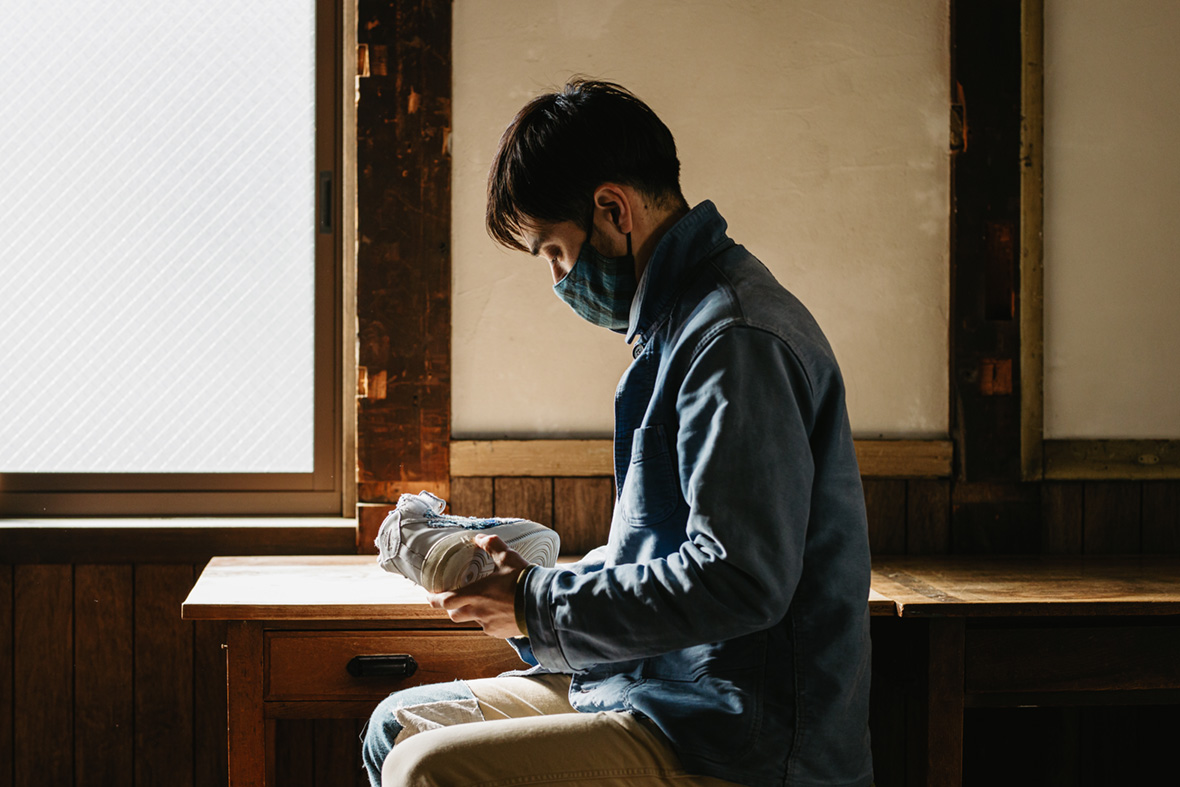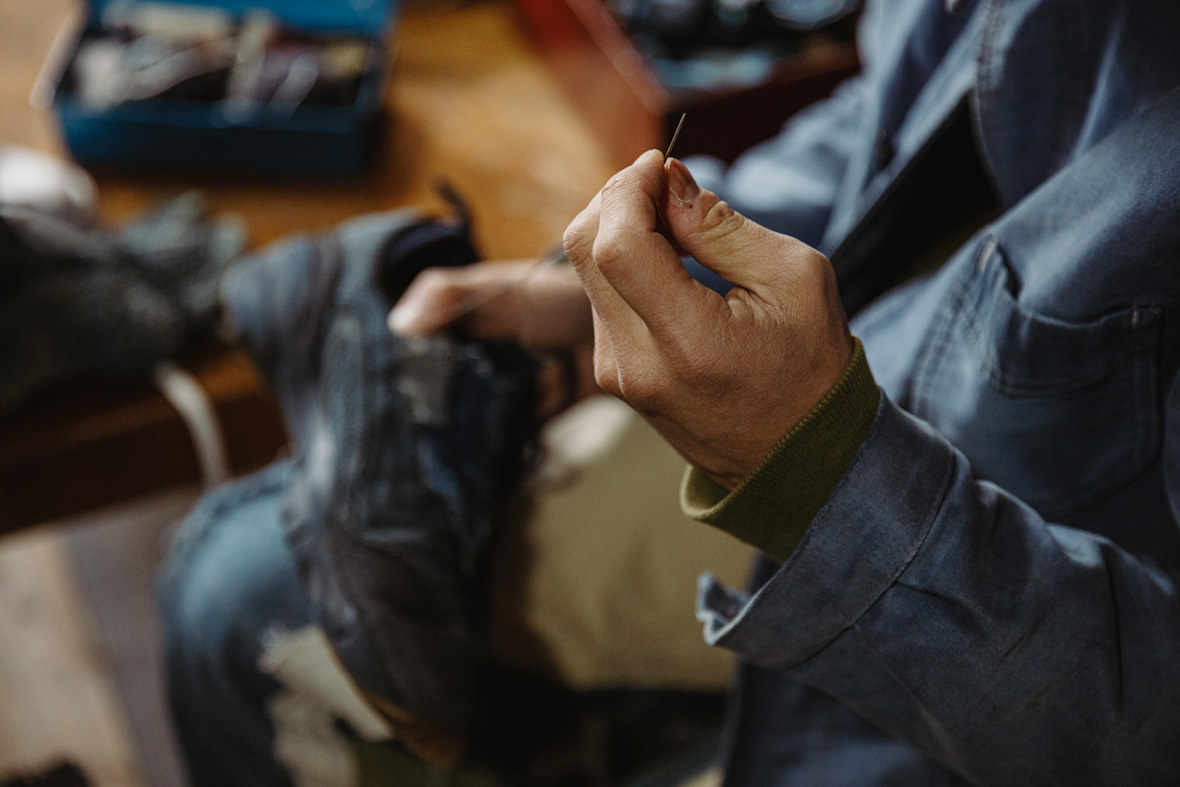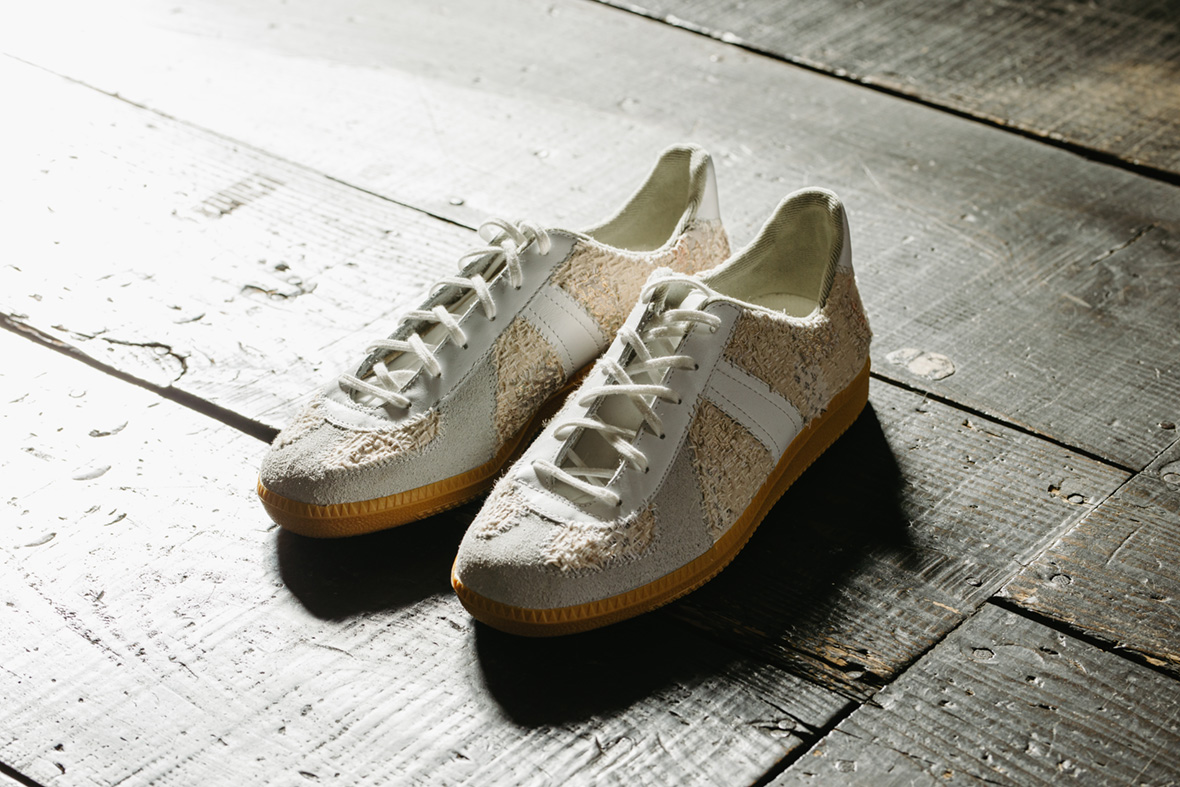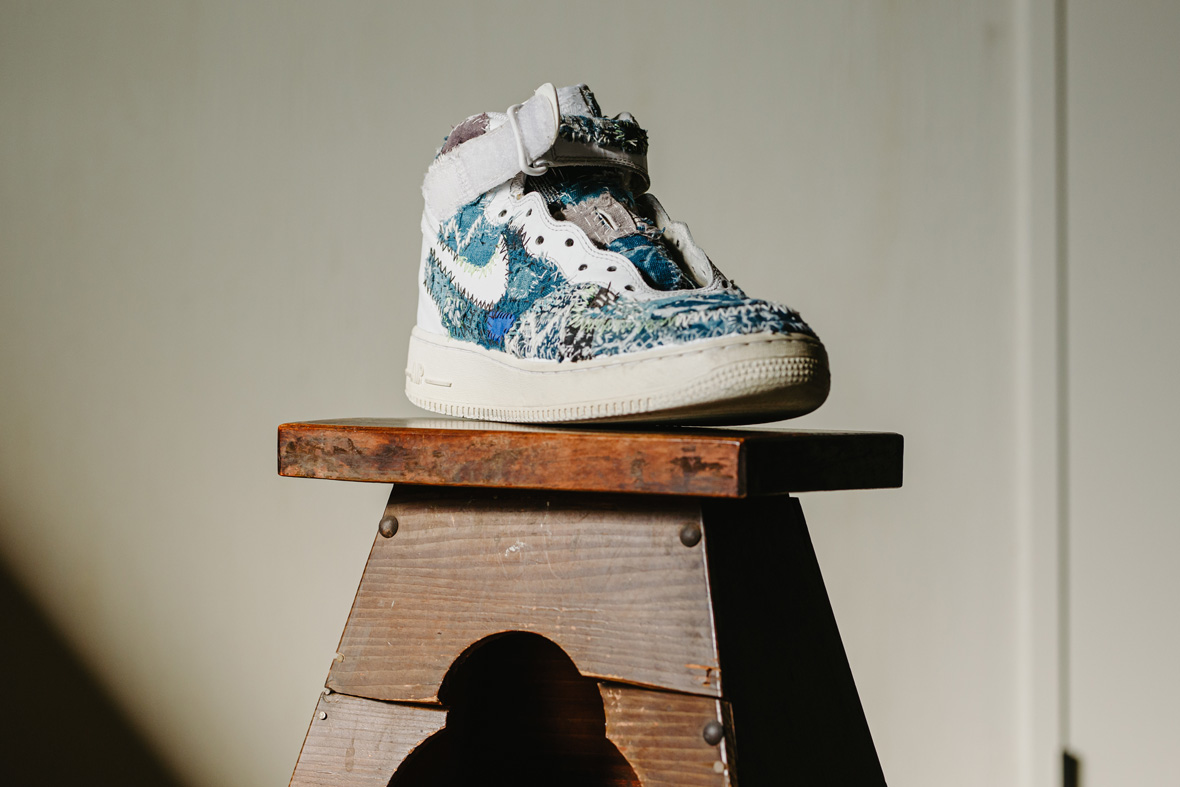
The customized sneakers of JunAle bring Japanese textile traditions to Western sneaker culture, adding a level of individuality that’s rare in the corporate-led industry. The amount of investment it takes to manufacture sneakers creates a high hurdle for alternatives to the giant global brands with their endless supply chains and massive advertising war chests. But the Osakan designer uses his mending skills and patchwork stylings to create unique footwear that shrugs off the hype cycle.
日本大阪设计师 Jun Ale 设计的运动鞋大部分都取自市面上常见的鞋款,不过通过日本传统布艺的加持,为大企业所导向的球鞋产业带来难得一见的个性元素。由于运动鞋的生产需要巨额投资,独立品牌往往难以与有着庞大供应链和广告投入的全球巨头相提并论。不过,Jun Ale 利用自己的修补与拼贴技术,创造出独一无二的风格,尝试打破运动鞋行业的一贯规则,令人眼前一亮!
Sitting in his small studio surrounded by piles of fabric scraps, JuneAle, who’s real name is June Sugimae, is focused on his work, sewing a paisley patch onto a lightly used pair of navy blue trainers. His design repertoire is heavy on indigo and denim, which are combined in layered patterns with contrasting stitches applied liberally. Oftentimes he’ll simply use stitches to create new patterns, covering the entire existing surface of a pair of sneakers with exposed threads. The Nike Air Footscape in his hands already looks a bit like the vintage tabi shoes on the table in front of him—albeit without the split toes—so he builds on that connection to guide his new design. “I’ve always been interested in bringing new life to old things in ways that will promote greater posterity,” he says. “I also believe that incorporating new elements into traditional designs can create a new and greater worth that is even perhaps more relevant.”
His studio is an extension of that belief, a converted printing press near the historic Tokaido Road that runs between Osaka and Tokyo. “I’ve always wanted to do my design work somewhere with a sense of place and history,” Sugimae says.
在 Jun 不大的工作室里,四下堆满了零散面料,他正专注地埋头工作,将佩斯利贴片(paisley patch)缝到一对几乎全新的海军蓝色球鞋上。Jun 的大部分设计主要采用靛蓝染色和牛仔布,层层叠搭图案,并通过大量对比色的缝线贯穿细节。他擅用缝线来完成图案轮廓,由裸露的针线点缀整个鞋面。
你看,Nike Air Footscape 在他的改造之后,看上去和桌子上的复古 Tabi 分趾鞋已有几分相像,只不过少了分趾的造型。他常常在不同球鞋之间建立联系,雕琢出属于自己的风格。他说:“我一直喜欢重新演绎传统,让过去的鞋子焕发出新的生命力。我相信,将新元素融入传统设计能带来完全不同的价值表现,也让设计变得更有趣。”
而他的工作室本身就是这一信念的完美诠释。其前身是一间印刷厂,坐落于大阪和东京之间别具历史意义的东海道(Tokaido)附近。Jun 说:“这算是我的一个心愿,希望能在历史和文化气息浓厚的空间里创作。”
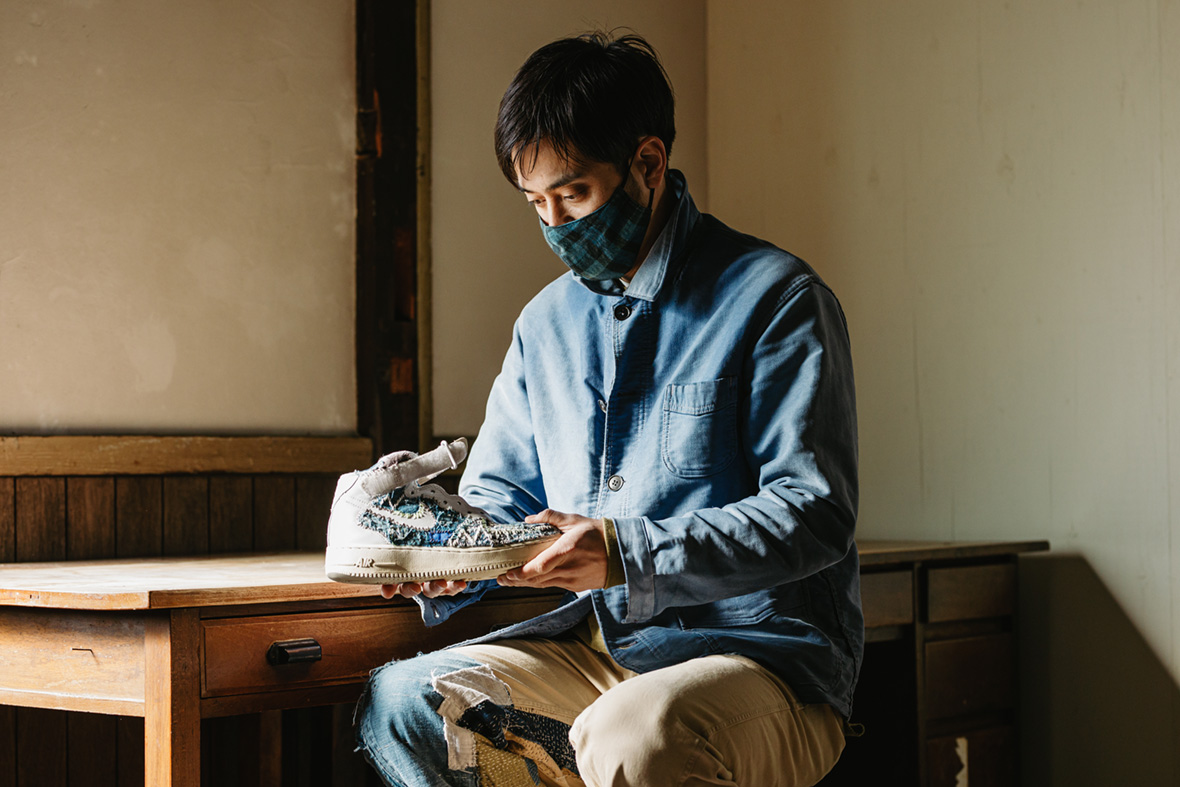
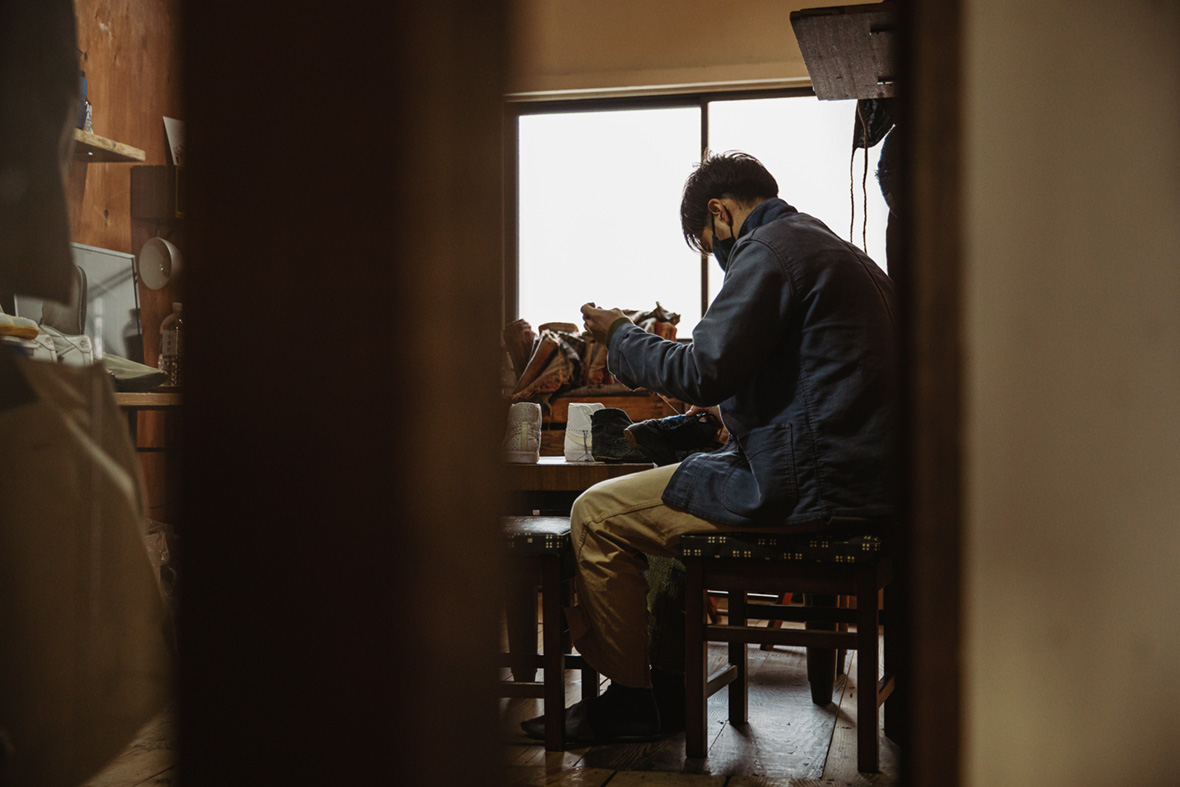
Sugimae studied fashion and tailoring in Japan and London and has over ten years of experience designing sportswear, but he only started upcycling about seven years ago. He also makes clothing using upcycled fabrics. He sources his materials from antique stores in the countryside and some local marketplaces in Osaka and Tokyo.
Jun 曾在日本和伦敦学习时装和裁缝,拥有超过十年的运动服饰经验。大约在七年前,他便开始专注于旧物的改造设计。由他一手打造原创的品牌 JunAle 也有对回收面料的再加工,其中用到的一些设计原材料均来自日本古着店以及大阪、东京的市集。

His sneakers are about 60 percent upcycled, depending on the order from a customer or his own personal inspiration. He mostly works with Nikes and slip-on Vans, sometimes using a fresh new pair from the box. “When I work on used sneakers, I try to mend holes, rips, and breaks with sashiko hand stitches,” Sugimae explains. “It has good chemistry, so I prefer used sneakers rather than new ones.” This traditional stitching from the 1600s is decorative as well as functional, so in addition to repairing them, he’s giving them a renewed sense of style.
在 Jun 设计的球鞋中,有一半以上都来自旧物回收。一些设计来自客户订单需求;另外一些则出自他的个人灵感。其中大多数是 Nike 和 Vans,新旧鞋参半。Jun 解释说:“二手运动鞋有很多岁月的痕迹,我尽量用刺子秀工艺(Sashiko)来缝补破洞和裂痕。出来的效果很好,所以相比于新鞋,我更喜欢用二手运动鞋创作。”这种起源于 1600 年代传统缝线工艺既具装饰性又实用,在修复鞋子之外,还能赋予鞋子一股新鲜的活力。
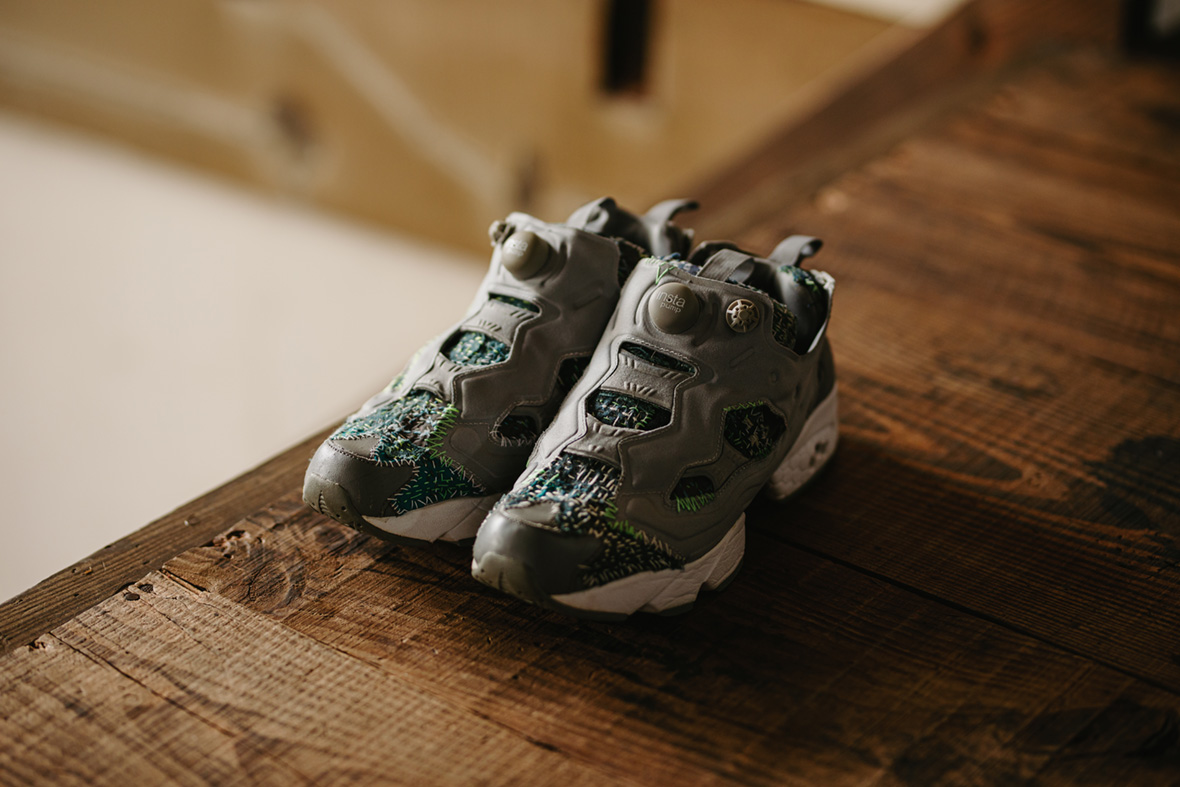
The process of customizing a pair of sneakers has different steps that depend on the type of sneaker Sugimae is working with. If he’s designing something for a customer, they’ll either send him a pair or ask him to pick something up locally, then they’ll discuss general design points and agree on an overall direction. Next, he figures out which materials match well with the sneakers. “This can be measured in harmony or contrast,” he explains. From there, materials and threading are applied one at a time. “Even if an application may appear jarring on its own, taken as an element in the greater picture, a cohesive artistic message can be relayed.” Each pair takes about a month or two to create, and he says his designs can last indefinitely since it’s usually the soles that take the most wear and tear and they can be replaced as many times as the owner wants.
不同类型的运动鞋,在设计时也需要 “对症下药”。如果有客户邀请设计球鞋,客户一般会事先把鞋子寄给他,然后一起讨论整体的设计方式,并达成共识。设计之初,他需要先确定哪些材料适合这双运动鞋。他解释说:“我要考虑所选材料是否与球鞋本身的设计想搭配;或形成强烈的对比反差。”在选择完成之后,他才能将材料和缝线同时添加到运动鞋表面。“即使单独一个的拼贴元素看起来格格不入,但放到整体的设计上,就能传达出某个一致的艺术讯息。”每双鞋的制作大约需要一两个月的时间。Jun 说自己改造的鞋子可以穿很久,因为通常承受磨损的只是鞋底,而他设计的鞋底是可以不断更换的。
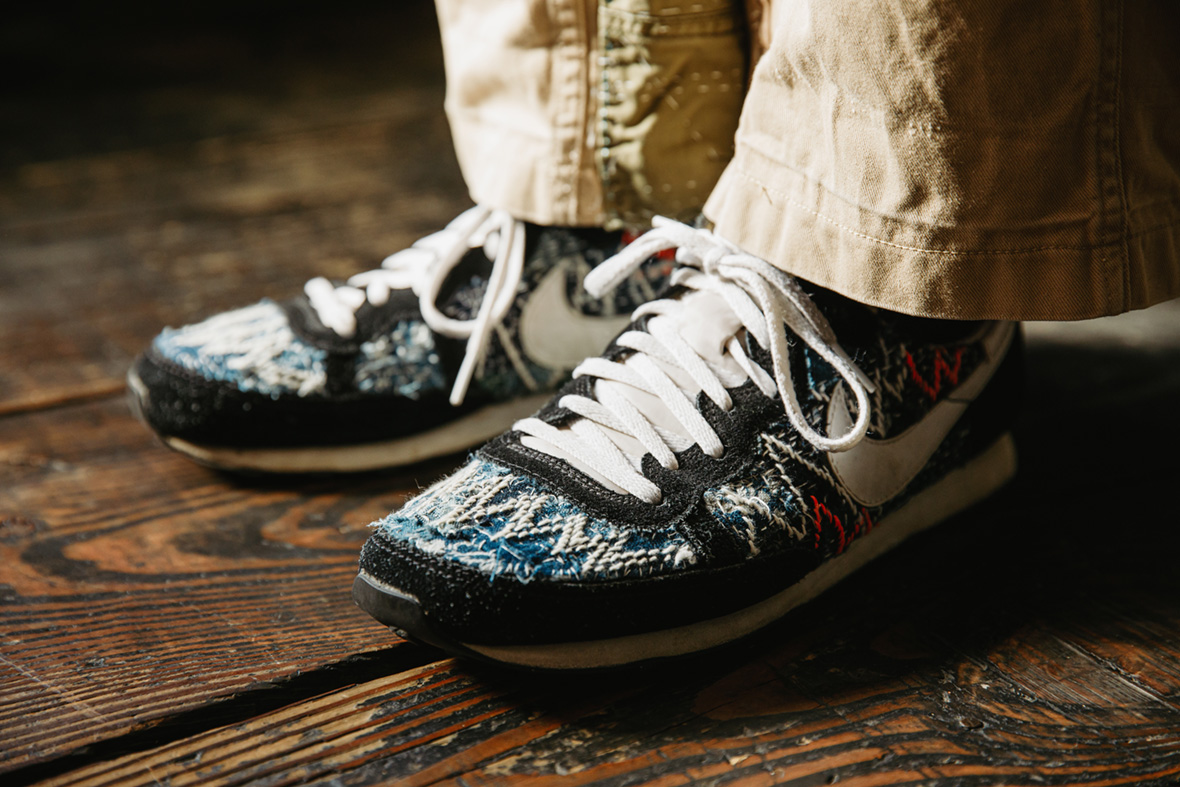
The particular style of upcycling that Sugimae practices is rooted in a Japanese tradition called boro, a process of mending and patchworking scraps to create a whole new piece of material. Boro was mainly used by the poor as an economic way to make clothes last longer and the materials were often dyed with indigo. But it was largely abandoned with the mass production of clothing in the 1900s. “I love a good and compelling folklore story that can be told without the use of the written word,” he smiles. “The emotions in such a work can reveal something that a text-based historical record may betray. Boro follows this thought line. The materials used invariably have a story and resulting symbolism. Through the discipline’s techniques, even poverty and shame can be elevated while still retaining purity, and this can be done all without words.”
其实“回收并改造”的灵感最早源于日本的民间传统——褴褛(Boro),指的是通过缝缝补补打造新衣服的传统拼布文化和工艺。以前的穷人通过褴褛来延长衣服的使用寿命,并往往会对面料进行靛蓝染色处理。后来到了二十世纪,大批量机器生产的出现导致这一种传统在很大程度上被人们遗忘。“不同于文字,还有更多方式可以深刻地讲述民间传统,就比如现在我在做的事情,带给人文字无法传达的感受。褴褛工艺正是如此。每一块材料的背后总有一段故事及其意义。藉由这种工艺,即使是原本代表贫苦与卑微的旧物也能得到升华,同时保持纯净,这一切的实现并不需借助任何文字,用心感受就好了。”
Like our stories? Follow us on Facebook and Instagram.
Website: www.junale.life
Instagram: @junale
Contributor: Mike Steyels
Photographer: Riku Yamashita
Chinese Translation: Olivia Li

